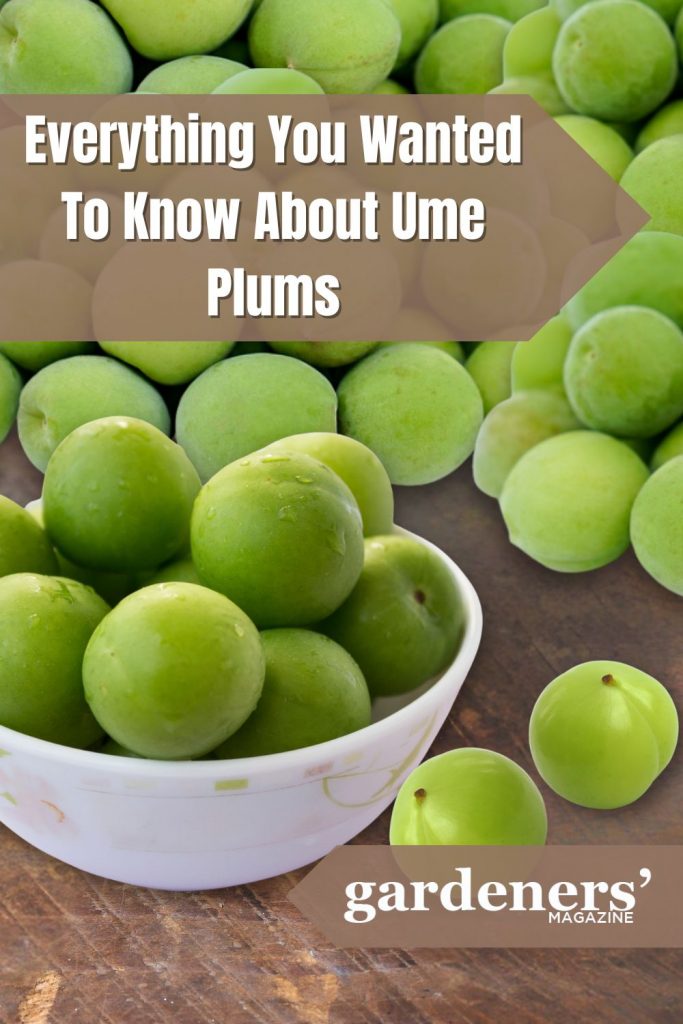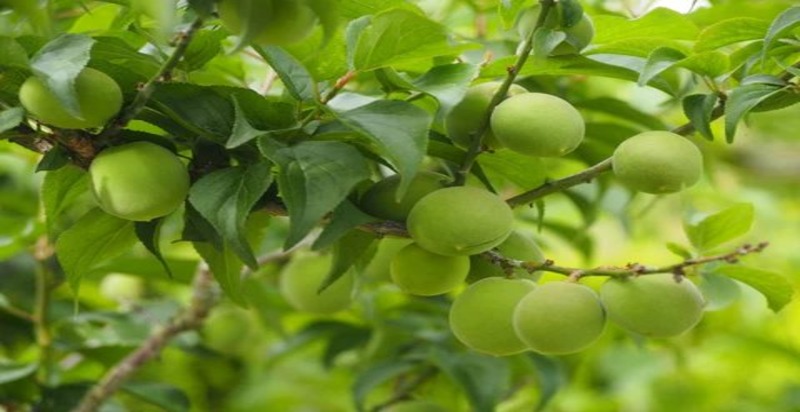Ume plums, or Japanese Plums, are a unique fruit native to Japan and East Asia that have been enjoyed for centuries. Rich in flavor and fragrance, they are distinct from other types of plum found worldwide and lend an unmistakable tanginess to food. In addition to their culinary uses, ume plums play an important role in Japanese culture and customs. From umeboshi, a traditional pickled plum, to umeshu, a sweet liqueur made from the fruit, these plums can be found all over Japan and are beloved by locals and visitors alike. Discover the unique taste of Japanese plums in this article as we explore their flavor profile and cultural associations.
About Ume Plums:
Ume plums, Japanese apricots, or Prunus mume, are fruits native to East Asia. When ripe, the fruits have a distinct sweet-sour flavor profile and an unmistakable vibrant pink hue. Ume plums are often used in Asian cooking and cuisine as they lend their unique tartness to dishes such as umeboshi (pickled plums) and oshibori (sweet or sour plum syrup).
Research has indicated that ume plums may help protect against cancer, heart disease, and oxidative stress. They are also known to improve digestion and promote healthy skin and hair. With their unique flavor profile and health benefits, Ume plums are an increasingly popular ingredient in many dishes worldwide. Whether you’re looking for a tart addition to your dish or want to reap the medicinal benefits of this amazing fruit, Ume plums are the perfect choice.
History and Origin of Ume Plums:
Ume plums have been a part of East Asian culture for centuries. The earliest written mentions of ume plums date back to the 8th century in Japan, where they were used as an ingredient in food and medicine. In China, the fruit has been associated with good fortune since ancient times and was presented as a symbol of abundance at Chinese weddings.
In Japan, ume plums are closely associated with the spring season. Every year in April, people celebrate Ume Matsuri (Plum Festival) by offering prayers to gods and dancing around a bonfire. Umeboshi remains an iconic dish of Japanese cuisine, as it is served during special occasions such as New Year’s Day or when welcoming guests into one’s home.
Today, ume plums can be found in many local Asian markets and specialty stores worldwide. They are also available canned or dried and frozen for convenience. With their unique flavor profile and health benefits, Ume plums continue to gain popularity among food lovers worldwide.

Description of Ume Plums:
Ume plums are small, round fruits that grow in clusters on trees. The average size of an ume plum is about 2-3 cm (0.8-1.2 inches) in diameter and has a reddish-green color with a light yellow or white center. The skin is thin and easily peeled off, while the flesh is juicy and tart.
The ume plum tree is a deciduous plant that blooms in late winter or early spring with small white flowers. Depending on the region’s climate, the fruit matures between May and July. Ume plums can be harvested at different ripening stages, leading to several varieties available for use in various recipes.
Flavor Profile of Ume Plums:
Ume plums, or ume fruits, have a unique flavor and scent that distinguishes them from other varieties of plum. Ume plums are quite sour due to their high acidity content, a characteristic that gives them their distinctive tangy taste. The acidity is balanced by sweetness and subtle floral notes, making it an ideal ingredient for cooking, baking, and preserving. Additionally, ume plums have a distinct aroma due to their high levels of essential oils in the fruit.
Seasonality and Availability Throughout the Year of Ume Plums:
Depending on the region’s climate, ume plums are generally available from May to July. Since they can be harvested at different ripening stages, they are often found in preserved forms year-round, such as pickled, canned, or dried. Frozen ume plums are becoming increasingly popular due to their convenience and long shelf life.
Health Benefits of Ume Plums:
Ume plums are a great source of essential vitamins and minerals such as A, C, and E. They are also rich in antioxidants, which can help reduce the risk of certain diseases. Additionally, Ume plums contain a high amount of dietary fiber, which aids in digestion and helps to regulate blood sugar levels. Furthermore, they possess anti-inflammatory properties, which may help with joint health, as well as provide a boost to the immune system.
Cultivation of the Ume Plums:
The cultivation of Ume plums is unique. The trees are typically planted as saplings, then pruned and grafted to develop a stronger rootstock. After grafting, the tree is trained into an arched structure or a fan shape to better support the weight of the ripe fruits.
In addition, the soil must be primed for the growth of Ume plums, require specific moisture and temperature conditions, and contain sufficient nutrients to ensure a successful harvest. Additionally, care must be taken to remove pests, weeds, and disease-carrying agents from the tree to achieve optimal growth and productivity. Furthermore, methods such as zig-zag pruning and fruit thinning must ensure the tree is adequately balanced with enough foliage and fruits.
Finally, careful harvesting practices are necessary to maintain the quality of Ume plums. The fruits must be picked at their peak ripeness and cautiously handled, as they are highly susceptible to bruising and damage. The harvest timing is also important as Ume plums must be picked before they soften to preserve their unique flavor and taste.
Harvesting of the Ume Plums:
The harvesting of Ume plums is a meticulous process that requires great skill and precision. The fruits should be picked when they are still firm to maintain their unique flavor, aroma, and texture. Fruit-picking techniques vary depending on the variety; some may require hand-picking into a basket, while others can be combed off with mechanical harvesters.
The harvest timing is also important as Ume plums ripen from late spring to early summer and must be picked before they soften. Once harvested, the fruits should be sorted according to size and quality and placed in open-top containers lined with paper or cardboard to protect against bruising during transportation.

Seasonality and Availability of Ume Plums:
Ume plums, native to Japan, have been cultivated for centuries. These trees thrive abundantly on the Honshu, Kyushu, and Shikoku islands, as well as in southern China. Although also found in some parts of Europe and North America, they are not commonly cultivated there.
The warm and humid climate in these regions is perfect for Ume plums to grow well. The trees require a long period of cool weather in the winter and plenty of sunlight in the summer. In addition to this, they need good drainage and rich, well-aerated soil.
A few Things to Remember When Buying Ume Plums:
When buying Ume plums, checking for signs of freshness is important. The fruits should be firm and free from blemishes, bruises, or cracks. Additionally, the skin should be slightly glossy with no brownish discoloration.
It is also advisable to buy fruits stored in a cool environment as they will stay fresh longer.
Regarding flavor, Ume plums can vary considerably depending on the variety and region where they are grown. To ensure you get the most out of your purchase, it is best to taste several different types before buying in bulk. This will help you determine which varieties have the right balance of sweetness and acidity to suit your taste.
Finally, store the Ume plums in a cool, dry place away from direct sunlight. This will help preserve the flavor of the fruit until you are ready to enjoy it.
Storing Preference for Ume Plums:
Ume plums can be stored for several weeks after harvesting. To ensure they retain their freshness, the fruit should be placed in a cool, dry place away from direct sunlight. Additionally, it is important to keep them in an airtight container to prevent moisture loss.
Ume plums can also be frozen for longer-term storage. To do so, the fruit should be placed in a sealed plastic bag and frozen for three to six months. When ready to use, thaw at room temperature before consuming.
It is best to avoid high temperatures and humidity to preserve the flavor of Ume plums, as these can cause them to spoil quickly. Additionally, it is important to prevent cross-contamination by storing them away from other fruits or vegetables.
Ume Plums with Other Fruits and Vegetables:
Ume plums can be used in various ways, depending on your preference. For example, they make an excellent addition to salads or topping for desserts. Additionally, they pair well with other fruits, such as apples and pears, due to their sweet-tart flavor profile.
Ume plums also work great in savory dishes such as stir-fries, curries, and stews. Similarly, they can be used to make jams and jellies or added to sauces for a unique flavor. Finally, due to their sour taste, Ume plums are also often used in pickling recipes. Whether you add them to sweet or savory dishes, Ume plums will surely add a unique flavor to your cooking.
Conclusion
Ume plums are a delicious and unique fruit with a sweet-tart flavor profile. Their versatility makes them highly adaptable for sweet and savory dishes, allowing you to create various recipes. Additionally, they can be stored for several weeks after harvesting or frozen for longer-term storage. With its many uses and health benefits, Ume plums are a unique and flavorful addition to any kitchen. Try them for yourself today!
Ever tasted Ciruela, also known as the Spanish Plum? It’s a juicy delight you won’t want to miss! Wondering what makes it special? Dive into our article to discover the sweet secrets of Ciruela, its origins, and how it can add a burst of flavor to your snacks and desserts.
- Everything You Wanted to Know About Red Tamarillos - June 2, 2025
- A Guide to Tulips: Everything You Need to Know & More… - June 2, 2025
- Guanabana: Description, Flavor, Benefits, And Uses - May 27, 2025

1 thought on “Everything You Wanted To Know About Ume Plums”
Comments are closed.